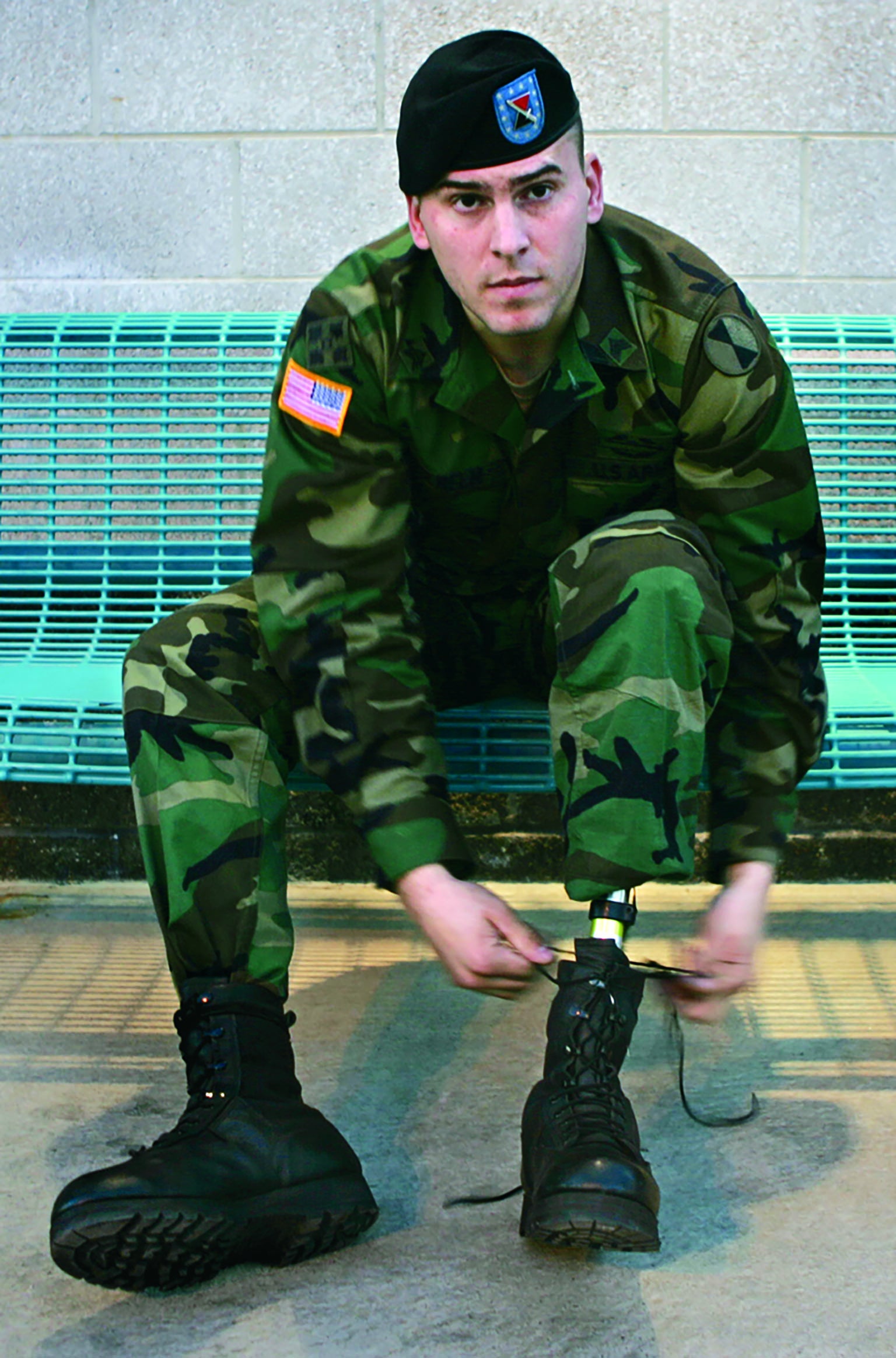As a college student at Brown University, Jerry White spent his junior year abroad studying in Israel. On a sunny day during the Passover holiday in April 1984, White and two friends set out for a camping trip in the Golan Heights. “I was walking out ahead of my friends with a song in my heart. I like being the leader, the one out in front,” he recalls. “Then, boom! A huge explosion.” He had stepped on a land mine. As blood poured from his leg, White screamed, “I have no foot! I have no foot!” White’s friends wrapped his stump with a shirt, tied a makeshift tourniquet around the injured leg and carried him through what they now knew was a minefield. For the next four months White lived in two Israeli hospitals where he felt helpless, sad and alone. “People were trying to introduce themselves, but they were all missing arms, legs, eyes, or they were burn victims. I felt sick and afraid,” he says.
Eventually White returned home, completed college and worked as a substitute teacher before becoming an activist working on behalf of fellow victims. In 1995 he, along with his friend and colleague Ken Rutherford, who had lost both legs to a land mine in Somalia, founded the Landmine Survivors Network (renamed Survivor Corps). This group played a leading role in the International Campaign to Ban Landmines, which was awarded the Nobel Peace Prize in 1997.
White’s transformation from frightened victim to passionate survivor demonstrates resilience, the “process of adapting well in the face of adversity, trauma, tragedy, threats or significant sources of stress,” according to the American Psychological Association. A resilient person may bend but does not break when confronted with adversity, enabling him or her to bounce back relatively quickly.

Biologically, resilience is the ability to modulate and constructively harness the stress response—a capacity essential to both physical and mental health. Unchecked, chronic stress can impair the immune system and contribute to illnesses such as gastric ulcers, asthma, depression, diabetes and heart disease. Stress can also spawn unhealthy behaviors such as smoking and excessive alcohol use.
Success appears to hinge on resilience. This is especially important during times of prolonged stress and suffering, such as the current COVID-19 pandemic. Setbacks are part of any human endeavor, and those who react to them productively will make the most progress.
Whether a person perseveres or gives up in hard times depends on influences at multiple levels, from molecules to neighborhoods. Resilience is determined by both inborn traits and environmental factors that affect the capacity to adapt to stress. Although some of these environmental influences, such as poverty, are difficult to alter, a person can increase his or her level of resilience by developing mental and physical habits that foster positive adaptation to stress and trauma.
Standing Up to Stress
Browse through the magazine section of any bookstore, and you will find an assortment of articles on how to reduce stress: “7 Rules for a Stress-Free Life,” “Leave Your Stress Behind,” “How You Can Reduce Your Stress and Your Dress Size,” and so on. The basic message is that stress is bad—but it is not always. Some stress is actually good. Without stress, we would weaken. And difficulty that can be mastered facilitates growth, self-esteem, self-efficacy and resilience. A resilient person is thus not someone who avoids stress but someone who learns how to tame it.
A body of data, including studies of identical twins, suggests that certain personal characteristics that foster resilience may be at least partly inherited. These traits include a temperament that leads a child to confidently take on novel tasks and interact with unfamiliar people, as well as a good-natured, sociable personality. Researchers are now uncovering some of the basic biology of resilience that facilitates our adaptive responses to stress [see box “The Biology of Bouncing Back” below].

Beyond biology, a number of environmental variables affect resilience, among them family support, the stability and quality of schools, and the services in and safety of a neighborhood. For example, a loner who is unemployed will have more trouble dealing with stress and trauma than a financially secure individual in a supportive family. Weak leadership in a community and insufficient first-responder and financial resources can also compromise responses to adversity.
Some of these situational factors, along with specific character traits, may be hard to change. Nevertheless, people can learn to think and act in ways that greatly enhance resilience. Virtually anyone can become more resilient through disciplined, consistent practice. The more we activate specific brain areas through our behavior, the more neural connections form in those areas, enabling the neurons involved to transmit their messages more efficiently.
In our book Resilience: The Science of Mastering Life’s Greatest Challenges, we identify 10 avenues for building resilience. Some of these strategies reduce stress. Others help you grow from the experience. Strategies to increase resilience include learning how to regulate your emotions, adopting a positive but realistic outlook, becoming physically fit, accepting challenges, maintaining a close and supportive social network, and observing and imitating resilient role models. We discuss each of these approaches below.
Emotional Rescue
The ability to regulate emotions such as sadness, anger and fear is critical for effectively coping with stress and trauma. Negative emotions are natural and often adaptive, but if left unchecked, they can seriously compromise our ability to think clearly and to make rational decisions in challenging situations.
Researchers have devised various strategies for regulating emotions and enhancing resilience. Two approaches that have received increasing scientific support in recent years are cognitive reappraisal and mindfulness meditation. Using reappraisal, individuals reinterpret the meaning of an adverse event so that they see it as less negative. Doing so tends to attenuate physiological and emotional reactions to the event. For example, psychologist Kevin Ochsner of Columbia University and his colleagues have shown that when people intentionally reinterpret a situation such as a rejection for a job as being less negative, they report a decrease in unpleasant emotions. Ochsner’s team also found that this improvement in mood is accompanied by changes in the brain—in particular, an increase in activity in the prefrontal cortex, a center for planning, directing and inhibiting behavior, and a decrease in activity of the amygdala, a hub for feelings such as fear.

For years researchers have studied how people regulate their emotions. Individuals who frequently use cognitive reappraisal as a way to alter their emotional reactions to stress and trauma tend to report greater psychological well-being than those who do not look for neutral or positive ways to interpret their challenging circumstances. For example, in a 2008 study we, along with psychiatrist Adriana Feder and other colleagues at the Icahn School of Medicine at Mount Sinai, interviewed 30 former Vietnam prisoners of war about how they evaluated their wartime experiences. We found that most of these veterans, many of whom had been brutally tortured, had actively reappraised their imprisonment and found meaningful ways in which they had grown stronger, wiser and more resilient as a result of it. They also reported that they were now better able to see possibilities for the future, relate to others and appreciate life.
Training in cognitive reappraisal is a component of various therapies designed to enhance well-being, strengthen resilience and reduce distress. For example, cognitive-behavioral therapies, which are effective for treating mood and anxiety disorders, teach individuals to observe their own thoughts and behaviors, to challenge their negative assessments of stressful situations and of themselves, and to replace these with more realistic and positive points of view. When faced with a highly stressful or negative episode, you may find it helpful to ask yourself a few questions: “Is there a less destructive way to look at this situation?” “Am I catastrophizing or exaggerating its potential negative impact?” “Is there something that I can learn from this experience, or is it possible to grow stronger as a result?
Another strategy for controlling stressful emotions is to engage in mindfulness meditation. This exercise teaches practitioners how to consciously live in the present moment rather than dwelling in the past or fretting about the future. The participant becomes an observer who learns to watch, but not judge, as the mind tends to automatically follow familiar conditioned patterns of thinking that often add to distress and maladaptive coping. Mindfulness meditation has been associated with improved ability to focus; more flexible thinking; greater psychological well-being; and better ability to cope with depression, anxiety and stress.
Brain-scanning experiments have revealed that both mindfulness meditation and training in cognitive reappraisal can increase activation of the left prefrontal cortex (a pattern associated with greater emotional control), which provides a boost in positive emotions and faster recovery from feelings such as anger, disgust and fear. Attending a workshop on mindfulness meditation is one good way to start learning how to modulate the stress response and successfully weather life’s many challenges.
A Glass Half Full
In addition to attenuating negative emotions, a dedicated effort to bolster positive emotions can enhance a person’s ability to bounce back from difficulty. Optimism and positive emotions are strongly associated with good mental and physical health, even longevity. In a remarkable study published in 2001 developmental psychologist Deborah D. Danner of the University of Kentucky and her colleagues examined autobiographical sketches composed by 180 nuns from the School Sisters of Notre Dame in Milwaukee before they took their vows of commitment to the Church and God. They found that the degree of positive emotion expressed in the sketches, which had been written decades earlier, predicted longevity. Only 34 percent of nuns whose sketches were classified in the lowest quarter of cheerfulness were still alive at age 85, compared with 90 percent who had been classified in the most upbeat quarter.

The health benefits of positive emotions probably stem from a better ability to regulate the stress response. Psychologist Barbara L. Fredrickson of the University of North Carolina at Chapel Hill and her colleagues have found that negative emotions tend to increase physiological arousal, narrow our focus of attention and restrict our behaviors to those essential for survival. Positive emotions, in contrast, have been found to reduce arousal and broaden our focus, leading to more creative and flexible responses to stress and trauma.
Resilience is associated with realistic optimism, not the rose-colored form. Because the latter often involves ignoring negative information, people who adopt an overly buoyant outlook tend to underestimate stressful and risky situations, whereas realistic optimists filter out unnecessary negative information but pay close attention to bad news that is relevant to dealing with adversity. To enhance optimism, focus on what is positive around you, intentionally think positive thoughts, embrace humor, reframe the negative in a more positive light, behave in ways that are known to be associated with positive emotions, and try to associate with positive friends and colleagues—emotions can be contagious.
Working Out Your Troubles
Physical activity can enhance resilience by protecting people (and animals) against the negative effects of stress. During the past two decades neuroscientist Benjamin N. Greenwood of the University of Colorado Denver and his colleagues have published a series of studies in rats showing that weeks of voluntary wheel-running exercise can ward off anxiety and depressionlike behaviors, such as exaggerated fear, reduced social exploration and increased intake of morphine, that can result from exposure to a variety of intense stressors.
In humans, aerobic exercise also has been shown to reduce symptoms of depression and anxiety. It improves attention, planning, decision-making and memory, all of which are important for effectively managing stress. Exercise appears to promote resilience through a number of neurobiological mechanisms. For example, it boosts levels of endorphins and of neurotransmitters such as dopamine and serotonin that may reduce symptoms of depression and elevate mood. It also suppresses the release of the stress hormone cortisol.

In addition, workouts seem to activate genes encoding proteins such as brain-derived neurotrophic factor (BDNF) that promote the growth and repair of neurons, which prolonged stress can damage. In a study published in 2011 psychologist Arthur F. Kramer, then at the University of Illinois at Urbana-Champaign, and his colleagues found that moderate-intensity aerobic exercise (three days a week for one year) increased the size of the hippocampus, a brain region that is involved in both memory and stress regulation, by 2 percent. This growth was associated with increases in BDNF levels and improved memory, suggesting that exercise can protect neurons in this area and may therefore help people recover from difficult circumstances.
For general health, the Department of Health and Human Services has recommended at least one hour and 15 minutes a week of intense aerobic workouts such as swimming or running or twice as much moderately intense exercise—mowing the lawn, say, or walking fast—along with two days of muscle strengthening. (Those who work out more tend to reap greater health benefits, although very intense or prolonged athletic endeavors can actually be detrimental to physical and mental health.)
To enhance resilience, however, we recommend that you consult with your physician and then develop a schedule in which you gradually increase the intensity of your cardiovascular and strength training. Every workout should be challenging but manageable. In this way, in addition to getting the biological benefits of exercise itself, you are also carefully calibrating your exposure to stress in a way that is known to increase resilience.
This general strategy is called stress inoculation. It is based on the notion that if a person deliberately takes on increasingly difficult challenges, he or she will gradually learn to handle higher levels of stress. The inoculation principle of graded exposure can apply to a broad range of activities designed to increase physical, emotional and cognitive resilience. For example, practitioners of mindfulness can increase their ability to concentrate by gradually lengthening their periods of meditation. A person who is afraid to give speeches might sign up for a public speaking workshop and afterward accept speaking engagements in front of small, nonthreatening audiences, then gradually agree to stand up in front of larger and more challenging crowds.
Such experiences should be outside your comfort zone but not so intense as to be unmanageable or potentially harmful. You should also plan to progressively increase the intensity or difficulty of these endeavors. As noted in the U.S. Army Combat Stress Control Handbook, “to achieve greater tolerance or acclimatization to a physical stressor, a progressively greater exposure is required. The exposure should be sufficient to produce more than the routine stress reflexes.... In other words you must stress the system.” Moreover, make training as realistic as possible. Pilots, firefighters, police and soldiers all enhance their physical, cognitive and emotional skills in realistic training settings where they can obtain constructive feedback from instructors and colleagues.
As you acclimate to greater levels of stress, you will need to recover and relax more. Psychologist James Loehr, who has written books on resilience training, points out that insufficient recovery relative to the high volume of stress can be quite damaging. One of the most important life skills may be knowing when high recovery needs to balance high stress.
Friends in Need
A particularly effective way to enhance resilience is to strengthen your relationships because doing so can dampen your biological response to stress and bolster your courage in tense situations. High levels of social support have been associated with better psychological outcomes after many types of trauma, including childhood sexual abuse and combat. High social support has also been linked with protection against depression and stress disorders such as PTSD, as well as greater emotional well-being and longer life. In contrast, social isolation has a negative impact on psychological and physical health, with effects on longevity similar to those of a sedentary life style, obesity or cigarette smoking.
Backing from others is powerful because it increases an individual’s self-confidence, provides a safety net if we should fall and bolsters our belief that we can overcome obstacles. As a result, we tend to more actively solve problems rather than passively avoiding challenges. After all, bonding with others does provide greater security; a group that works closely together is stronger than an individual. On a biological level, social ties activate the parasympathetic nervous system, which lowers subjective and physiological measures of stress and prompts the release of the hormone oxytocin. Oxytocin is known to reduce anxiety and fear, in part by limiting the cortisol response to stress. (It also promotes affiliative behaviors and emotions, such as trust, that encourage continued socializing.)

Interestingly, social support may have an even stronger effect on coping with adversity in Latin American and other cultures that place great value on interdependence, extended kinship systems and collectivism. It plays a comparatively lesser role in more individualistic cultures, although relationships in all societies are vital.
To boost resilience through your relationships, first evaluate your social network. Make a list of the people you feel connected to. With whom do you interact daily? Who would help you without hesitation? To whom do you turn for advice? Who really understands you? Resilience is strongly associated with altruism and giving support to others.
If you find you need to bolster or simply maintain a supportive network, reach out to family, friends and colleagues. Join organizations that share your interests and concerns. Find ways to help others. As an adult, it is also important to teach kids the skills needed to become socially competent, such as knowing how to listen to and empathize with others.
More Than Flattery
In your social circles, look for people who recover quickly from hardship whom you could learn from. Members of your own family, colleagues, teachers, coaches, or even historical figures or fictional characters could also serve as resilient role models.

Psychologist Albert Bandura, a highly influential emeritus professor at Stanford University, believes that modeling is most effective when the observer has analyzed what he or she wishes to imitate by dissecting it into segments and creating rules that could guide future action. For example, when a friend lost her job, we noticed that she immediately called fellow employees, former employers and friends to solicit their help in searching for a new position. When she fell ill with pneumonia, she moved in with her sister until she recovered. And when her mother died, she called her family and closest friends and asked them to spend time with her. Rather than going it alone in times of stress, she reached out for support from those who care about her, a pattern that can guide our own behavior. Other resilience-enhancing attitudes and behaviors include perseverance and endurance, moral character and virtues, toughness tempered by compassion, altruism, dignity in the face of deprivation and potential growth from suffering.
The resilience-enhancing strategies described above can be powerful tools for dealing with life’s challenges, including the COVID-19 pandemic. This pandemic has caused unprecedented levels of stress, trauma and depression among the general public and among frontline health-care workers, who have risked their own lives to save the lives of their patients.
White, the land-mine survivor, is an outstanding model of resilience. Through years of soul-searching (read: cognitive reappraisal), he began to see the loss of his foot as more opportunity than horrendous misfortune. Together with a group of like-minded individuals, he embarked on a quest to rid the world of land mines. Through thoughtful reassessment, social support and a problem-solving approach, White transformed his tragedy into a mission of hope.


